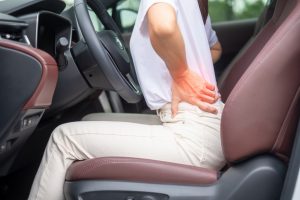Ruptured Disc
A ruptured disc, also known as a herniated disc, is a common condition that occurs when one of the spinal discs develops a crack in its tough outer wall and its inner disc material is pushed out into the spinal canal. This can result in pain and other symptoms if any displaced disc material puts pressure on the spinal cord or nerve root.
If discomfort and limited mobility from a ruptured disc have become debilitating and make it difficult for you to accomplish everyday tasks, learning about your condition can help you be aware of what to expect. Being able to ask the right questions and better understand the answers may help you get the care you need to resume a healthy and active lifestyle.
Causes
Ruptured discs can develop anywhere in the spine. Most develop in the lumbar (lower) spine, although the cervical (upper) spine area is also a common location for a ruptured disc. Oftentimes, a ruptured disc develops through wear and tear with age. The discs are made of soft but strong connective tissue and act as a shock absorber for the pressure placed on the neck and back every day. Through a person’s lifetime, these discs gradually lose the elasticity necessary to keep them flexible.
The deterioration of these discs can cause the formation of small cracks to develop in the outer wall, which can further develop into full tears. Pressure from the surrounding vertebrae can then cause the fluid in the core of the discs to be pushed out through the tear and into the spinal column. Less commonly, a rupture can be caused by a sudden traumatic injury such as a car crash. People whose jobs involve prolonged exposure to the regular lifting of heavy items are also prone to disc ruptures.
Conservative Treatment Options
Upon diagnosis, the healthcare professional will review conservative treatment options that could offer the patient relief. Conservative options include:
- Over-the-counter medications
- Prescription medication
- Physical therapy
- Lifestyle changes
If a patient has tried these methods and does not feel relief after several weeks, they may be a potential candidate for surgery.
Symptoms
Many individuals with a ruptured disc will not experience any symptoms. In fact, they might not even know they have a ruptured disc until it is discovered through diagnostic tests. However, if there is any nerve compression or irritation resulting from the disc rupturing, the individual could experience extreme symptoms including:
- Local pain
- Shooting or burning pain that travels the length of the nerve
- Numbness
- Muscle weakness
- Tingling
- Loss of movement
If you are experiencing any of these symptoms and your lifestyle is being negatively affected as a result, you should consult with your doctor to review possible treatment options.
Diagnosis
During the diagnostic process, the patient will undergo a series of examinations. First, the medical professional will review the patient’s symptoms and medical history, and will then begin a physical examination to determine the location of the patient’s symptoms. If the doctor suspects it could be a ruptured disc, he may issue diagnostic imaging to confirm. CT scans and MRIs can allow the doctor to see the inner workings of the patient’s spine and will help them give an accurate diagnosis.
Surgical Treatment Options
Some patients may need more than conservative treatments to relieve their symptoms and let them get back to the people and activities that they’ve been missing. If this is the case, your doctor may recommend a surgical approach. The dedicated healthcare professionals at BEST Health System specialize in minimally-invasive surgical procedures that will allow you to resume your typical lifestyle.
BEST Health System
If you are interested in learning more about the surgical procedures offered through BEST Health System, reach out to our team and take the first step towards recovery.
Related Articles
Ruptured Disc - Causes
What is a Ruptured Disc? A ruptured disc, also called a herniated disc, occurs when a tear develops in the outer layer of a spinal […]
Ruptured Disc Symptoms
What is a Ruptured Disc? Symptoms of a ruptured disc occur when one or more of the spine’s discs becomes damaged and pushes into the […]
What Causes a Ruptured Disc?
A ruptured disc, also called a herniated disc, occurs when a tear develops in the outer layer of a spinal disc. Then, pressure from the […]
Physical Therapy for Ruptured Discs
What is a Ruptured Disc? A ruptured disc occurs when the disc’s outer layer breaks and the gel-like material inside is pushed out into the […]
Overview of Ruptured Discs
A ruptured disc, also known as a herniated disc, is a common condition that occurs when one of the spinal discs develops a crack in […]
What is Spondylolisthesis? Understanding Causes and Treatment
Spondylolisthesis comes from the Greek terms for “spine” and “slipping,” so it literally means spinal slipping. It can be a fairly common cause of spinal […]





